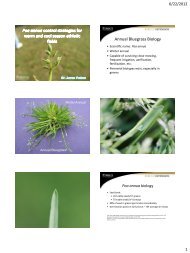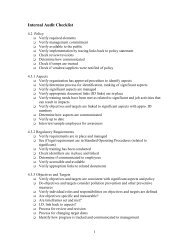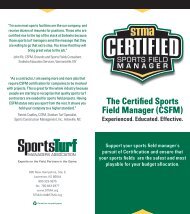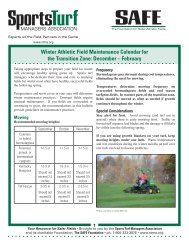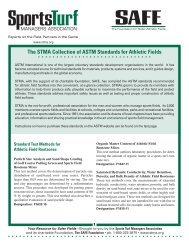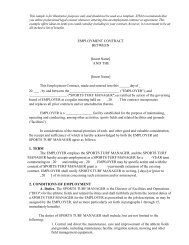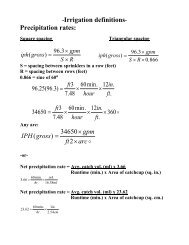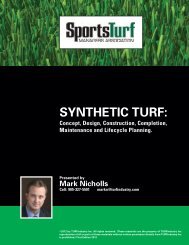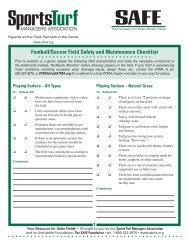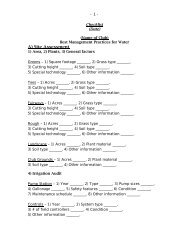Backpack and Hand-Held Sprayer Calibration Worksheet - STMA
Backpack and Hand-Held Sprayer Calibration Worksheet - STMA
Backpack and Hand-Held Sprayer Calibration Worksheet - STMA
You also want an ePaper? Increase the reach of your titles
YUMPU automatically turns print PDFs into web optimized ePapers that Google loves.
<strong>Backpack</strong> <strong>and</strong> H<strong>and</strong>-<strong>Held</strong> <strong>Sprayer</strong> <strong>Calibration</strong>Remember:1 acre = 43,560 square feet1/128th of an acre = 340.31 square feet1/128th of an acre = 18.5 feet by 18.5 feet1 gallon = 128 fluid ouncesA worksheet has been provided at the end of the document to help you move through each step <strong>and</strong> calculation tosuccessfully calibrate your sprayer.Collect materials needed to calibrate the sprayer:• <strong>Sprayer</strong>• Correct spray tips (if using more than one, the tips are identical)• Measuring tape• Water• Flags or turf paint• Measuring container (measurement in fluid ounces)• StopwatchStep 1: Determine application pressure <strong>and</strong> timing.Mark off an area 18.5 feet by 18.5 feet. Turf paint or flags can be used to establishboundaries.Fill the sprayer tank ½ full of clean water. Use only clean water during calibration.Never add pesticides to a sprayer until it is properly calibrated <strong>and</strong> ready for use.Pump to the normal operating pressure to simulate the average spray situation.Walk at a comfortable, steady speed while spraying to achieve uniform coverage.Maintain consistent pressure while spraying. Measure the time in seconds ittakes to uniformly spray the 18.5 feet by 18.5 feet area. Record the time.Example:It took 46 seconds to spray the 18.5 feet by 18.5 feet area.Step 2: Measure nozzle output.Photo courtesy of Michael Goatley, Jr., Ph.D.Nozzle flow rate is the amount of liquid sprayed from the nozzle in a given amount of time. Operate the sprayer withwater in the tank at the desired pressure. Using a stopwatch <strong>and</strong> measuring cup marked in fluid ounces, collect waterfrom the nozzle for the time (in seconds) it took to spray the predetermined area. Record the amount collected. Repeatthis process 2-3 times to get the average nozzle output.3Your Resource for Safer Fields • Brought to you by the Sports Turf Managers Association<strong>and</strong> its charitable Foundation, The SAFE Foundation • ph. 1-800-323-3875 • www.stma.org
<strong>Backpack</strong> <strong>and</strong> H<strong>and</strong>-<strong>Held</strong> <strong>Sprayer</strong> <strong>Calibration</strong>Note: Application rates can be highly variable withbackpack or h<strong>and</strong>-held sprayers. Simple adjustments canbe made to ensure a consistent application rate. To increaseapplication rates, the operator can increase pressure <strong>and</strong>to decrease application rates, the operator can decreasepressure.Example:The first amount collected after 46 seconds is 44 fluid ounces.The second amount collected after 46 seconds is 45 fluidounces.The third amount collected after 46 seconds is 44 fluid ounces.The average output of the nozzle is 44 fluid ounces.Photo courtesy of Michael Goatley, Jr., Ph.D.The sprayer is now correctly calibrated. The average amount of watercollected in fluid ounces equals the gallons applied per acre (GPA).Example:44 fluid ounces is the average nozzle output. Therefore, the sprayer is calibrated to deliver 44 gallons per acre.Remember:The concept of the 128th method is based on the time it takes to spray 128th of an acre with a single nozzle. That timerequirement is then used to collect fluid ounces from a single nozzle. Since there are 128 fluid ounces in a gallon, thesimple conversion or result is in gallons per acre (GPA).Multiple NozzlesIf there is more than one nozzle being used, check theuniformity of all nozzles on the boom. Collect the watersprayed from each nozzle individually for the time (inseconds) it took to spray the predetermined area. Aftercatching the spray from each nozzle individually, add theamounts collected <strong>and</strong> divide by the number of nozzlesto get the average output per nozzle. If the flow rate ofany spray tip is 7% greater or less than the average nozzleoutput, clean or replace the nozzle tip. If any of the nozzlesneed to be cleaned or replaced, recheck the output from allnozzles <strong>and</strong> recalculate the average.Photo courtesy of Michael Goatley, Jr., Ph.D.4Your Resource for Safer Fields • Brought to you by the Sports Turf Managers Association<strong>and</strong> its charitable Foundation, The SAFE Foundation • ph. 1-800-323-3875 • www.stma.org
<strong>Backpack</strong> <strong>and</strong> H<strong>and</strong>-<strong>Held</strong> <strong>Sprayer</strong> <strong>Calibration</strong>Example:Nozzle TestOutput collected from each nozzle after 46 seconds:Nozzle 1 – 44 fluid ouncesNozzle 2 – 45 fluid ouncesNozzle 3 – 44 fluid ouncesTotal output from all nozzles: 133 fluid ouncesDetermine average output for each nozzle:133 fluid ounces3 nozzles= 44.3 or 44 fluid ounces average nozzle outputRemember:Sum of total fluid ouncesNumber of nozzles= average nozzle output in fluid ouncesCheck that all nozzles are within 7 percent of the average nozzle output.0.07 x 44 fluid ounces = 3.08The acceptable range for nozzle output is between 40.9 to 47.1 fluid ounces. All of the nozzles in the example fall withinthe acceptable range. If they do not, clean or replace the spray tips <strong>and</strong> repeat this step.The sprayer is now correctly calibrated. The average amount of watercollected in fluid ounces equals the gallons applied per acre (GPA).Example:44 fluid ounces was the average nozzle output. Therefore, the sprayer is calibrated to deliver 44 gallons per acre.5Your Resource for Safer Fields • Brought to you by the Sports Turf Managers Association<strong>and</strong> its charitable Foundation, The SAFE Foundation • ph. 1-800-323-3875 • www.stma.org
<strong>Backpack</strong> <strong>and</strong> H<strong>and</strong>-<strong>Held</strong> <strong>Sprayer</strong> <strong>Calibration</strong>Tips for Product ApplicationCorrect <strong>and</strong> accurate application of any pesticide product to a turfgrass area is essential to prevent damage to theturfgrass <strong>and</strong> prevent pollution of water sources. Use the following tips for accurate <strong>and</strong> safe applications with yoursprayer:• Read all product labels to ensure safe h<strong>and</strong>ling, proper application, <strong>and</strong> correct use rates. In addition, be sure tocomply with all state <strong>and</strong> federal environmental regulations.• Make sure the sprayer is in good operating condition. Review the Pre-<strong>Calibration</strong> Checklist before each pesticideapplication.• Calibrate the sprayer every fourth application (if using the same applicator) or every application (if a new applicator)to ensure the sprayer <strong>and</strong> nozzles are still delivering the correct volume of product.• Always stay a safe distance from water sources to prevent any possible pollution.• Don’t apply pesticides on windy days (less than 7 mph or less than 5 mph near sensitive crops).• Maintain a consistent walking speed <strong>and</strong> pressure during calibration <strong>and</strong> match it during application to deliver anaccurate amount of product.• Use different sprayers for insecticide <strong>and</strong> herbicide applications.• Be sure to clean the sprayer thoroughly after applying pesticide products to prevent build up <strong>and</strong> corrosion onsprayer parts.6Your Resource for Safer Fields • Brought to you by the Sports Turf Managers Association<strong>and</strong> its charitable Foundation, The SAFE Foundation • ph. 1-800-323-3875 • www.stma.org
<strong>Backpack</strong> <strong>and</strong> H<strong>and</strong>-<strong>Held</strong> <strong>Sprayer</strong> <strong>Calibration</strong> <strong>Worksheet</strong>Total output from the nozzle (sum of the 3 collections):fluid ouncesDetermine average output:fluid ounces3= fluid ounces for average nozzle outputAverage nozzle output: fluid ounces is equal to GPAThe sprayer is calibrated to deliver gallons per acre.Multiple NozzlesIf there are multiple nozzles, check that all nozzles are within 7 percent of the average nozzle output by determiningthe range.0.07 x fluid ounces = (range)Minimum acceptable fluid ounces that can be collected from each nozzle:fluid ounces - = fluid ouncesMaximum acceptable fluid ounces that can be collected from each nozzle:fluid ounces + = fluid ouncesThe acceptable range for individual nozzle output is between fluid ounces to fluid ounces.If a nozzle does not fall within the acceptable range, clean or replace the nozzle <strong>and</strong> repeat this step. Once nozzle outputfalls within the acceptable range, the sprayer is calibrated.Remember, the concept of the 128th method is based on the time it takes to spray 128th of an acre with a single nozzle.That time requirement is then used to collect fluid ounces from a single nozzle. Since there are 128 fluid ounces in agallon, the simple conversion or result is in gallons per acre (GPA).Average nozzle output: fluid ounces is equal to GPAThe sprayer is calibrated to deliver gallons per acre.References:<strong>STMA</strong> Information Outreach CommitteeUniversity of Missouri – Calibrating Pump-up Can or Solo-type <strong>Backpack</strong> <strong>Sprayer</strong>sOregon State – Calibrating <strong>and</strong> Using <strong>Backpack</strong> <strong>Sprayer</strong>s - http://extension.oregonstate.edu/linn/sites/default/files/pnw_320_calibrating_<strong>and</strong>_using_backpack_sprayers.pdfVirginia Tech – Calibrating H<strong>and</strong>-held <strong>and</strong> <strong>Backpack</strong> <strong>Sprayer</strong>s for Applying Pesticides - http://pubs.ext.vt.edu/456/456-502/456-502.htmlNorth Carolina State University – Calibrating a <strong>Backpack</strong> <strong>Sprayer</strong> - https://www.bae.ncsu.edu/topic/agmachine/turf/pubs/ag-576-callibrating_backpack_sprayer.pdf8Your Resource for Safer Fields • Brought to you by the Sports Turf Managers Association<strong>and</strong> its charitable Foundation, The SAFE Foundation • ph. 1-800-323-3875 • www.stma.org



